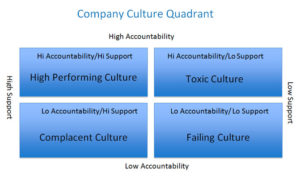Building a High Performance Culture: A Two-Dimensional Model
Building a high performance culture is the capstone of excellent leadership. However, achieving the right balance between driving accountability and supporting individual employee success is not easy to achieve. Too much focus on numbers and position accountability could result in a toxic workplace while too little position accountability invites complacency or indifference. Focusing on accountability and employee support is a two dimensional leadership model that works, regardless of the environment.
The First Dimension: Driving Accountability
Without position and personal accountability, productivity and performance falters. Too often, accountability is replaced by creative excuses or just incompetence. It is important to remember that every employee has individual issues around accountability so it is imperative that individual and team issues are always addressed together. What are some of the key aspects of leading and managing accountability? How can you promote accountability without ever using the word, by embedding it in everything an employee touches? Here are the very basic elements of inculcating accountability into a work culture:
- Throw “job descriptions” away. Every position has results and those results could change yearly based on the Strategic Plan. Position Results Statements®[Atkinson] (PRS)- Every person knows what success in the organization looks like in terms of specific measurable results for their position, their department and their organization. This applies to all positions up and down the organization. Expectations of performance is clear and every result is measurable, with appropriate deadlines. These deadlines do NOT change; strategies for meeting those results might.
- How each employee will be measured is objective (no subjective measures) and clearly understood by all employees… if you can’t measure it, you can’t use it.
- There is a clear line of accountability throughout the organization. Everyone knows who they are directly accountable to for results.
- There are consequences for not meeting measureable results, and they are known up front, BEFORE they start the measurable results for the fiscal year.
- The company gives monthly updates on measured results individually, departmentally, and as an organization, and makes changes to strategies or approaches but not targeted outcomes/results. You don’t lower your results to meet your lack of accountability; you examine your strategies to see which are working for you and which are not, and you change your strategies.
- Every employee can view each department’s measured objective results against goal on a monthly, quarterly, and yearly basis.
The Second Dimension: Driving Support
Without sufficient individual and team support, employees may end up feeling neglected, frustrated and/or pressured without knowing how to perform their work effectively. Embedded into employee practices are those components that have been proven to drive heightened performance:
- Every employee is ‘coached’ on how to more effectively achieve the desired measurable results for their position and their department on a monthly basis
- Every leader/manager coaches each direct report on a monthly basis
- Every manager is coached on how to mentor employees who are not delivering
- Every employee receives at minimum two full weeks of training every year in an area their manager/supervisor agrees on. It is important that the employee received training in an area in which they are interested.
- Every employee is assigned a mentor and those mentors are trained in how to mentor properly. This mentor training cannot be taken lightly, and part of a mentor’s position description is how well they are mentoring.
- Every employee must take their vacation. It is important that leaders encourage everyone in the organization to take care of themselves and to have some down time. Leaders should model this.
- Any and every employee is rewarded financially for any idea brought forward which brings in additional revenue to the organization.
- Team meetings include all three: information updates, training/learning, and inspirational stories/wins/successes/best practices. Meetings should center around one operational result and should never last more than 30 minutes.
- C-Level leaders are provided 360 feedback and input from employees on an annual basis, held accountable by a board of directors, and receive coaching by a board appointed executive consultant.
Achieving the right mix of ‘high expectations’ coupled with equal parts ‘acknowledgement and support’ can build high performing, strong corporate cultures. Too little support with too much pressure to perform creates ‘toxic’ cultures that cause turnover and deplete valuable talent. Too little accountability with strong support creates complacent cultures that can be over-taken by competitors who are producing faster and better results. Cultures that fail to hold people to account while also failing to provide support are likely going to fail.
How close is your company to hitting the optimal balance?
Dr. John Musser, (www.salespotential.com 800-880-6607, drjohn@salespotential.com) is an organizational psychologist who works with companies to build strong cultures of high performance. Position Results Statements® is a registered tool designed by Dr. Ann Atkinson, renowned organizational consultant and successful facilitator of high performing organizations.

